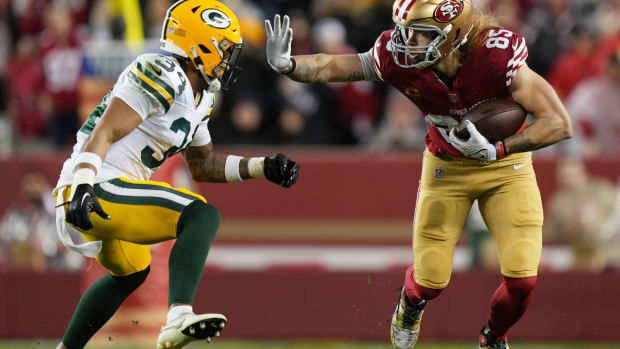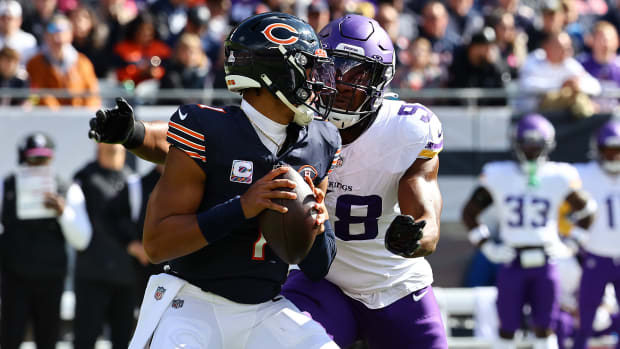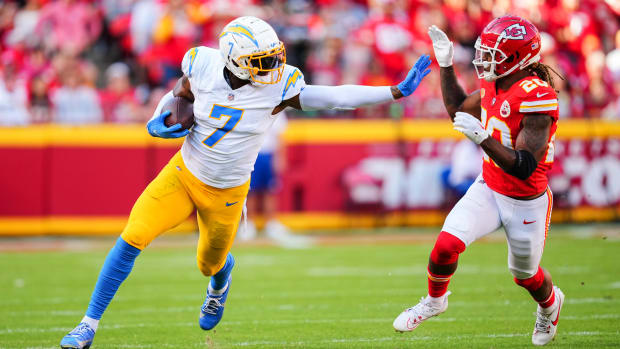Promise Over Production
Before he went off into personnel limbo, former Bears general manager Ryan Pace left the team with the draft class of 2020.
There can be no doubt this was his best overall attempt to bring in college players. Three players became starters as rookies—Cole Kmet, Darnell Mooney and Jaylon Johnson. By Year 2, fifth-rounder Trevis Gipson contributed enough as a third edge pass rusher to equal a Bears high achieved by 2016 first-round draft pick Leonard Floyd.
They had no picks in the first, third or fourth rounds and came out of it with a very successful draft.
Pace's final draft class did not achieve the same immediate success his 2020 class did.
The potential of Justin Fields in that draft, along with Teven Jenkins, Larry Borom and Khalil Herbert, make it possible the 2021 class will eventually be looked upon as a similar success.
There were more players in the 2021 class who need more time to develop.
That development will continue in 2022 under new coaches. Here is how the rookie class performed and the keys for their future improvement.
Round 7, Pick 250
DT Khyiris Tonga, BYU
Job Performance: The big rookie played far more than a seventh-round defensive line pick could expect, with 216 defensive plays. That was 23% of the snaps. He also played on a quarter of the special teams snaps. Occupying blockers from a two-gap position on the line doesn't lend itself to stats but Tonga still got in on 24 tackles.
Key to Progress: Tonga's chances took a blow with the hiring of Matt Eberflus because they are switching to a 4-3 with a one-gap philosophy. Tonga is the massive roadblock and not a gap attacker. Still, teams need role players who can help in specific situations. Expect Tonga to lose a little weight and to become a short-yardage and goal-line specialist in this defensive scheme. There is a nose tackle on a four-man front but they do not line up directly over the center or play the same role so Tonga needs to adjust.
Round 6, Pick 228
CB Thomas Graham Jr., Oregon
Job Performance: He was cut and brought back to the practice squad but by season's end showed the talent Pace said he saw on draft day. Graham had been highly graded in numerous predraft scouting reports, particularly in the one by Pro Football Focus. They called him a third-round talent. Graham showed a feisty attitude and challenged for the ball when activated, which other cornerbacks seemed unwilling or unable to do. He made 13 tackles and four pass defenses despite playing just 112 snaps, or less than 15% of the team's defensive plays. It was a strong finish for a player coaches initially thought didn't deserve to be on the team, which showed maybe someone in personnel, the coaching staff or both had initially made a mistake.
Key to Progress: Gaining experience is the key. Coaches said this about him at the outset because he had opted out in college during 2020, but how does a player gain experience when cut, and when buried then on the scout team? Key for improvement will be if he studies receivers and learns the defensive scheme better because he did get beaten badly by DK Metcalf for a long TD catch and no one ever accused Metcalf of being a great route runner. He also would do well to expand his horizons and learn the nickel position. The Bears need both a nickel and left cornerback. Perhaps Graham is part of the answer.
Round 6, Pick 221
WR Dazz Newsome, North Carolina
Job Performance: He went through the same situation as Graham, and was cut. Coaches called him raw, and so did GM Ryan Pace. It seemed at season's end he had figured what needed to be done within the offense because one of the two receptions he made in three games was a key third-down reception for a first down. With Jakeem Grant on the roster it would seem his chances to impress as a punt returner will be limited but this is one of his strengths and he showed it with a 12.5-yard average for six returns, including a 28-yarder.
Key to Progress: He was called a good route runner coming in and agreed with that but quickly found out running routes in college is much easier. So becoming better with routes is critical because he is not unusually fast. In fact, his 40 time was listed at 4.59 seconds. If Newsome can get to 20 receptions in his second year it will be great progress. The opportunity could be there because free agency could take away four or five receivers.
Round 6, Pick 217
RB Khalil Herbert, Virginia Tech
Job Performance: Proved an excellent complement in style and skills to David Montgomery and ran for 433 yards on 103 carries. He was above average on kick returns with a 24.1-yard average and also contributed 14 catches for 96 yards. His effort against the Raiders helped make possible a win. They got all of this from a player who was expected to be the third back and mainly a special teams player, since Damien Williams had initially been the backup. Herbert took that role and kept it.
Key to Progress: It might help him if they find another kick returner so he can concentrate on offense. The relief back/backup needs to be available. Also, working on his hands as a receiver and running through tackles when holes are not there or close on him are points for improvement.
Round 5, Pick 151
T Larry Borom, Missouri
Job Performance: Inconsistency as a run blocker was offset by a better-than-expected effort blocking the pass, something most fifth-round draft picks might struggle to accomplish. He started eight games and played in 10, and was there when they didn't have second-round pick Teven Jenkins. Pro Football Focus gave him a 61.4 overall grade, which is relatively high for a rookie tackle though not for a veteran. He allowed five sacks and committed four penalties.
Key to Progress: He'll need to get into better shape and lose some weight. The new offense relies on movement for blockers and a wide zone scheme. Remaining square with his pass blocking technique is another goal. It's unclear whether the new staff will view him as a starter yet or as a competitor. He'll need to come to camp ready for anything.
Round 2, Pick 39
T Teven Jenkins, Oklahoma State
Job Performance: Incomplete would be his grade if he received one. PFF assigned him a disappointing 47.5 score but his brief playing time -- 160 offensive snaps -- after his back surgery did indicate he can be a powerful run blocker. He was obviously overmatched as a pass blocking left tackle.
Key to Progress: Because of his back surgery, the first key is health. Beyond this, it's going to be establishing his position. They might move him to right tackle if they come up with a free agent left tackle. For Jenkins, he'll need to view this as his rookie year.
Round 1, Pick 11
QB Justin Fields, Ohio State
Job Performance: Being a rookie accounted for his early struggles with consistency, then injuries prevented him from seizing upon momentum from a "breakout" game against Pittsburgh. Fields displayed accurate enough deep passes but an unwillingness to take the short throws given by the defense. He became more comfortable with knowing when and where to scramble as the season continued. Fields was the second best quarterback of the draft class, all skills measured.
Key to Progress: It depends more on the Bears. Will they get him the line to help him avoid something like 36 sacks again? Can they find dependable receivers for him besides Darnell Mooney? Will Luke Getsy design an offense around him to take advantage of his skills and let him play faster without thinking. Naturally Fields needs to continue improving at reading defenses but the bulk of his progress is going to need to result from help the team gets him. He needs to play now in an offense that lets him plays and not one seeking to contain him.
Twitter: BearDigest@BearsOnMaven





